A Visit with Colonel Thomas Monstery, and a Conversation About the Art of Defense
“A neater and more effective blow was never struck by the human fist…”
The following gem of an article, entitled “The Use of the Fists: How to Employ Nature’s Bony Weapons Effectively,” appeared in the June 13, 1886 issue of the Chicago Tribune, and contains a firsthand account, by a reporter, of a visit to the school of the noted duelist, swordsman, martial artist, soldier, and adventurer, Colonel Thomas H. Monstery.
Monstery, who reportedly fought more than fifty duels and served as a soldier under twelve flags, taught a system of self-defense that included punching, kicking, grappling, head-butting, and other techniques of unarmed and armed self-defense, as detailed in his martial arts treatise, recently republished as Self-Defense for Gentlemen and Ladies.
The article that follows, which contains a lengthy interview with Monstery, includes several illustrations clearly based on those published in Monstery’s treatise, however, they have also been embellished with additional detail and features to make the figures more closely resemble Monstery.
This article gives additional insight into the life, mind, and techniques of this remarkable character.
A Talk with Col. Monstery, the Veteran Soldier, Swordsman and Instructor—Popularity of the Fistic Art Increasing In Chicago—How Jem Mace Was Astonished by an Amateur He Expected to Amuse Himself With—A Sixty-Odd Year Career of Stirring Adventures.
A few days ago a gang of laborers were at work upon the foundations of a new building in the business portion of the city when one of them, a burly Celt, objected to the order given to him by the superintendent of the work. The latter, a fine-looking splendidly-proportioned man of 30 or thereabouts, insisted on the fulfillment of his instructions. He was fashionably dressed, but it was very evident that he was a man who would stand no nonsense. The laborer demurred, and the superintendent insisted. The refractory Hibernian muttered. something about “not taking no orders from no blankety-blank swell.” There was a cold, steely gleam In the eyes of the superintendent. He approached the recalcitrant knight of the hod and let out his right arm with the swift direct movement of a piston-rod. His clenched fist came into contact with a Milesian jaw, and a burly son of Erin dropped down among the surrounding bricks and mortar. A neater and more effective blow was never struck by the human fist. The discomfited laborer presently picked himself up, shook the brick dust from his hair, and went to work. The gladiator in broadcloth saw his order executed and went his way, followed by the admiring glances of the bystanders.
“Who is he?” was asked of a bystander who had witnessed the brief encounter. “He is one of the best amateur boxers and general athletes in the West,” was the answer. “His name is Miles G. Nixon, and he is a well-known North Side resident.”
“But where did he learn his science?”
“His eyes are as keen as a hawk’s, his arms are like iron, and he is as active as an acrobat…”
 “Come with me and I will show you,” answered the bystander. And forthwith THE TRIBUNE reporter was led to a building on Randolph street up two narrow flights of stairs and into a spacious room that looked like a small arsenal as much as anything. The walls were invisible by reason of the swords of every variety, the gloves of all sorts, the paraphernalia for every kind of athletic pastime and exercise which depended thereon. Two young men occupied the centre of the apartment. Their heads and bodies were protected by masks and armor so effectually that they resembled Paul Boynton full aquatic regalia. They were going through one broadsword exercise, and were at it hammer and tongs, while a third person stood by, sword in hand, giving points and illustrating with precept and practice. At the entrance of visitors the combatants ceased their cutting and slashing, while the instructor came forward, and the reporter was introduced to Col. Thomas H. Monstery, a man who ties been concerned as principal or second in over forty affairs of honor, who fought valiantly in the Mexican War and in the recent “unpleasantness” and whose anatomy is a perfect war-map of scars and wounds. The Colonel is nearly 65 years old. He is a trifle under six feet in height and his figure is as upright as a plumb-line. His light-brown hair is brushed straight back from his forehead, his mustache and goatee are carefully wrought to a point at each extremity and he is the picture of an old soldier. His eyes are as keen as a hawk’s, his arms are like iron, and he is as active as an acrobat. Such is Col. Monstery, master of the art of fence and expert at athletes in general at your service. He smiled a bland and complacent smile when the episode in fisticuffs related above was told to him. “Aha! I should like to have been there,” he exclaimed. “I don’t blame the poor fellow for dropping all in a heap. That blow is one that there is no standing against; that is the Monstery blow.”
“Come with me and I will show you,” answered the bystander. And forthwith THE TRIBUNE reporter was led to a building on Randolph street up two narrow flights of stairs and into a spacious room that looked like a small arsenal as much as anything. The walls were invisible by reason of the swords of every variety, the gloves of all sorts, the paraphernalia for every kind of athletic pastime and exercise which depended thereon. Two young men occupied the centre of the apartment. Their heads and bodies were protected by masks and armor so effectually that they resembled Paul Boynton full aquatic regalia. They were going through one broadsword exercise, and were at it hammer and tongs, while a third person stood by, sword in hand, giving points and illustrating with precept and practice. At the entrance of visitors the combatants ceased their cutting and slashing, while the instructor came forward, and the reporter was introduced to Col. Thomas H. Monstery, a man who ties been concerned as principal or second in over forty affairs of honor, who fought valiantly in the Mexican War and in the recent “unpleasantness” and whose anatomy is a perfect war-map of scars and wounds. The Colonel is nearly 65 years old. He is a trifle under six feet in height and his figure is as upright as a plumb-line. His light-brown hair is brushed straight back from his forehead, his mustache and goatee are carefully wrought to a point at each extremity and he is the picture of an old soldier. His eyes are as keen as a hawk’s, his arms are like iron, and he is as active as an acrobat. Such is Col. Monstery, master of the art of fence and expert at athletes in general at your service. He smiled a bland and complacent smile when the episode in fisticuffs related above was told to him. “Aha! I should like to have been there,” he exclaimed. “I don’t blame the poor fellow for dropping all in a heap. That blow is one that there is no standing against; that is the Monstery blow.”
“Excuse my ignorance, Colonel, but what is the Monstery blow?”
“If I deliver a thrust with the ‘line of power’ behind it, the bones and muscles all backing each other with cumulative force, the foil would go right through you…”
“Well, you must know that I am the originator of a system of scientific boxing. I introduced ten years or more ago the method of evasion as a means of defense preferable to parrying; ‘ducking’ is the current term for it. The offensive tactics are the more important however; the blow is the great thing in boxing. Success all lies in knowing how to hit—to establish a line of power from the shoulder to the knuckles of the second, third and fore fingers. The principle is the same in fencing. Let me take a foil and deliver a thrust glancing downward and the point will only scratch you, whereas if I deliver a thrust with the ‘line of power’ behind it, the bones and muscles all backing each other with cumulative force, the foil would go right through you. I discovered the scientific blow that Sullivan uses—his ‘knock-out’ blow. It remained for a man thoroughly acquainted with the art of fencing to discover this blow, which is produced exactly like a thrust in tierce, see? A blow so dealt by a powerful man will stun an ox, and a scientific lightweight or gentleman amateur can by means of it hold his own against any slugger in the ring who is unfamiliar with the principle. A man who is an accomplished fencer is invariably a good boxer; not because sword practice develops a quick eye and general activity, but because his cuts and thrusts when used with the fist as the weapon are the most powerful and effective blows that can be used on an opponent.”
“Do you find that boxing is a popular study with young men at present?”
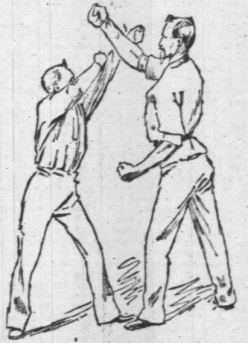 “Yes, the cultivation of the noble art is widely in favor and increasing in popularity. When I first taught in New York I found that the young men there thought boxing rather a degrading pastime; but I had not been long in Gotham when I had some of the leading younger citizens among my pupils. I taught Col. Jim Fisk boxing and fencing up to the day of his death. Fred May, who challenged James Gordon Bennett, you remember, took boxing lessons from me and he is an accomplished athlete. You know Francis Wilson the comedian, of course? Well, Wilson is not only the champion amateur swordsman of the United States, but he is also an artistic handler of his fists. Among other pupils I had in New York were Frederick Sharon, son of the Senator, James Gordon Bennett, Junius Brutus Booth, the actor who died recently. George Seligman, the bankers son, and a host of others whom I could name.”
“Yes, the cultivation of the noble art is widely in favor and increasing in popularity. When I first taught in New York I found that the young men there thought boxing rather a degrading pastime; but I had not been long in Gotham when I had some of the leading younger citizens among my pupils. I taught Col. Jim Fisk boxing and fencing up to the day of his death. Fred May, who challenged James Gordon Bennett, you remember, took boxing lessons from me and he is an accomplished athlete. You know Francis Wilson the comedian, of course? Well, Wilson is not only the champion amateur swordsman of the United States, but he is also an artistic handler of his fists. Among other pupils I had in New York were Frederick Sharon, son of the Senator, James Gordon Bennett, Junius Brutus Booth, the actor who died recently. George Seligman, the bankers son, and a host of others whom I could name.”
“How do Chicago amateurs rank in numbers and proficiency?”
“I find that there is a very general desire to learn the science of boxing. It seems to be more popular than fencing, probably because in this country it comes into more practical use. The fists are more favored weapons than rapiers or small swords. I have a number of well-known young men who come to me for lessons. Among them are Messrs. Miles G. Nixon, Al Meeker, Le Grand Smith, F. A. Pettibone, Charles Stephenson, and a score of others.”
“It was a victory of genuine science over what is known as ‘science’ in the ring…”
“None of your gentlemen amateurs could stand up against a professional pugilist, I presume.”
“Now, that is where you are mistaken.” responded the Colonel. I will give you an illustration. You have heard of the Olympic Club of San Francisco, one of the finest organizations devoted to athletic sports that ever existed in America? Of course you have. Well, in 1860 I was the instructor of that club and I introduced my system of boxing. We had young men there in that club, lithe, sinewy active fellows who used to make such a showing against the brawn and brute strength of professional pugilists that the Olympic Club of ‘Frisco became famous the country over. I had a pupil there, a young man by the name of Bennett, a fellow who compounded drugs at a corner pharmacy all day and devoted his nights to physical culture. He was an enthusiast and afterward died from the effects of overexertion. When Jem Mace, at the height of his fame, visited ‘Frisco young Bennett met him in the ring. Outsiders laughed knowingly at he thought of the way Mace was going to “do up” the audacious amateur. Mace himself seemed to think that he was going to have things all his own way. His first surprise was when Bennett parried all his best blows, and he was still more astonished when he found the druggist getting in hits that seemed of tremendous force for a middle-weight They fought six rounds and at the end of the sixth, Mace wished he had never tackled the amateur. It was a victory of genuine science over what is known as “science” in the ring. The meeting was private, but Bennett’s victory is a matter of record in spite of Mace’s efforts to hush the matter up.”
“While he may have twice the muscular strength of a scientific boxer, he will be helpless when his force encounters superior skill…”
“I can tell you, there is no such boxer as the gentleman amateur when he is properly instructed and has a fairly powerful physique as a foundation for his skill. Take an ordinary workingman, and while he may have twice the muscular strength of a scientific boxer, he will be helpless when his force encounters superior skill. This Mr. Bennett to whom I refer was by no means the best man in the Olympic Club. Probably the champion of the organization was William O’Reilly, who was one of the most artistic boxers I ever saw. When George Rooke was at his best, O’Reilly met and vanquished him. I also taught young Robinson, who held his own so well against Slade, the Maori. Jem Mace used to claim that in this encounter, O’Reilly’s success was owing to the Maori purposely not having done his best, but that is a rather gauzy subterfuge. Tommy Chandler, the celebrated lightweight, was a pupil of mine, and he uses my mode of hitting with telling effect.”
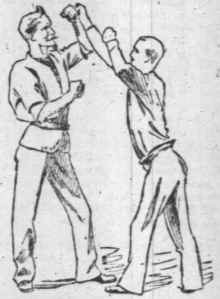 Col. Monstery has had a most interesting career made up of exciting experiences. He prides himself upon his finesse as a swordsman rather than on his skill with what pugilists would call his “dukes.” He has taught fencing to many stage celebrities, among the number Ada Isaacs Menken, Lola Montez, Dolly Davenport, Maud Forrester. Helen Temple, Adele Belgarde, Edwin Forrest, John McCullough, Frank Mayo, Lawrence Barrett, Daniel Bandmann, Charles R. Thorne Jr., Junius Brutus Booth the younger, and many lesser luminaries. Francis Wilson studied fencing, as well as boxing, with the Colonel, and the popular comedian succeeded in capturing the gold medal as amateur champion at the competitive games of the New York Athletic CIub in 1877.
Col. Monstery has had a most interesting career made up of exciting experiences. He prides himself upon his finesse as a swordsman rather than on his skill with what pugilists would call his “dukes.” He has taught fencing to many stage celebrities, among the number Ada Isaacs Menken, Lola Montez, Dolly Davenport, Maud Forrester. Helen Temple, Adele Belgarde, Edwin Forrest, John McCullough, Frank Mayo, Lawrence Barrett, Daniel Bandmann, Charles R. Thorne Jr., Junius Brutus Booth the younger, and many lesser luminaries. Francis Wilson studied fencing, as well as boxing, with the Colonel, and the popular comedian succeeded in capturing the gold medal as amateur champion at the competitive games of the New York Athletic CIub in 1877.
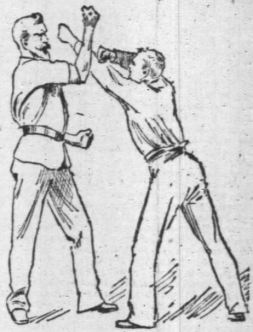 Baltimore was the Colonel’s birthplace, and his parents were Scandinavians. While he was in his early teens his father removed to Copenhagen and the lad entered the Naval Academy at the Danish Capital. Here he distinguished himself by capturing nearly all the prizes offered for athletic proficiency and he proved a terror to all who ventured to cross swords with him. His prowess received a setback, however, when in a sham fight indulged in by the cadets an explosion seriously injured his eyes. Medical skill and judicious care soon repaired the damage wrought and he was enabled to pursue his studies and exercise. After his graduation an encounter with swords, resulting in the serious wounding of his antagonist, caused young Monstery to flee from Denmark. He visited Russia, Germany, France, and England and afterward journeyed through Spain, Italy, and Holland. Everywhere his capabilities as a swordsman were of service, as the duel had not then—in 1843—fallen into disuse and disrepute. In 1845 he came to America and visited Washington, hoping by means of letters of recommendation and introduction to obtain a commission in the army, then warring In Mexico. As he was not a West Point graduate, the commission was refused. In 1849 the gold fever attracted him to California, whence he Journeyed to New Orleans, and afterward to Cuba. From there be found his way to Spain where he entered the Spanish service and was shortly afterward sent to Cuba to instruct the Spanish forces there garrisoned. At Havana, Col. Monstery met a Spaniard named Galletti, who bore the reputation of being the most skillful swordsman on the island. Just before the meeting which was arranged between the two Monstery was taken ill. A physician was called in to bleed him who succeeded in inflicting serious injury to the Colonel’s sword-arm. This physician afterward acknowledged that he was in the employ of Galletti. Subsequently the Colonel passed a number of years in the numerous Republics of Central America acting as drill-master and instructor in fencing and bayonet exercise. Here his adventures were romantic and exciting. The hero of all these escapades is a wonderfully preserved man and withal molest and unpretentious.
Baltimore was the Colonel’s birthplace, and his parents were Scandinavians. While he was in his early teens his father removed to Copenhagen and the lad entered the Naval Academy at the Danish Capital. Here he distinguished himself by capturing nearly all the prizes offered for athletic proficiency and he proved a terror to all who ventured to cross swords with him. His prowess received a setback, however, when in a sham fight indulged in by the cadets an explosion seriously injured his eyes. Medical skill and judicious care soon repaired the damage wrought and he was enabled to pursue his studies and exercise. After his graduation an encounter with swords, resulting in the serious wounding of his antagonist, caused young Monstery to flee from Denmark. He visited Russia, Germany, France, and England and afterward journeyed through Spain, Italy, and Holland. Everywhere his capabilities as a swordsman were of service, as the duel had not then—in 1843—fallen into disuse and disrepute. In 1845 he came to America and visited Washington, hoping by means of letters of recommendation and introduction to obtain a commission in the army, then warring In Mexico. As he was not a West Point graduate, the commission was refused. In 1849 the gold fever attracted him to California, whence he Journeyed to New Orleans, and afterward to Cuba. From there be found his way to Spain where he entered the Spanish service and was shortly afterward sent to Cuba to instruct the Spanish forces there garrisoned. At Havana, Col. Monstery met a Spaniard named Galletti, who bore the reputation of being the most skillful swordsman on the island. Just before the meeting which was arranged between the two Monstery was taken ill. A physician was called in to bleed him who succeeded in inflicting serious injury to the Colonel’s sword-arm. This physician afterward acknowledged that he was in the employ of Galletti. Subsequently the Colonel passed a number of years in the numerous Republics of Central America acting as drill-master and instructor in fencing and bayonet exercise. Here his adventures were romantic and exciting. The hero of all these escapades is a wonderfully preserved man and withal molest and unpretentious.
Colonel Thomas H. Monstery‘s martial wisdom survives in his treatise on Boxing, Kickling, Grappling, and Fencing with the Cane and Quarterstaff, which was recently published by North Atlantic Books in book form for the first time. This volume contains a new, detailed biography of Monstery, and includes additional writings by the Colonel.
Additional articles about Thomas H. Monstery can be found here as well.

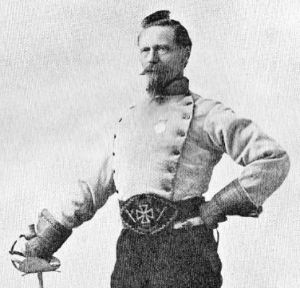
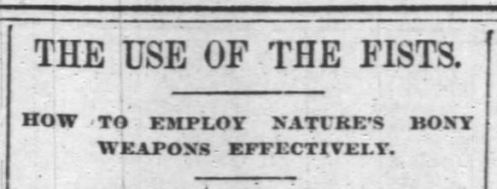
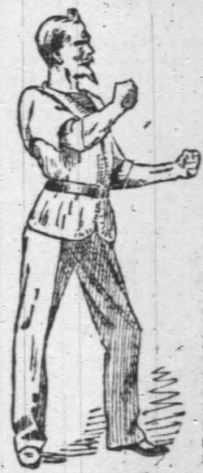
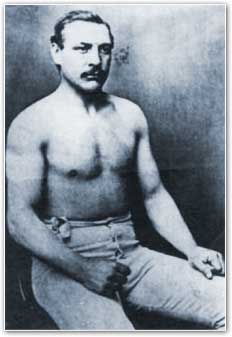
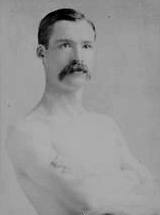
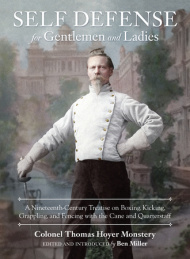

Trackbacks & Pingbacks